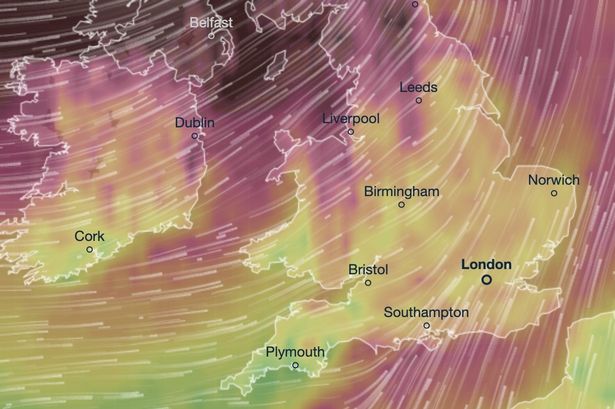Storm Éowyn, named by the UK Met Office, is poised to deliver a significant weather event across the United Kingdom starting Friday, impacting millions with strong winds, heavy rain, and potential disruptions. Current meteorological models predict a rapidly developing low-pressure system sweeping in from the Atlantic, intensifying as it approaches the British Isles. This intensification will generate powerful gusts, particularly along coastal regions and exposed areas, potentially reaching gale force and posing risks of localized damage, travel disruptions, and power outages. The storm’s track suggests a wide swathe of the country will experience adverse weather, with initial impacts felt across western areas before spreading eastward throughout the weekend.
The initial phase of Storm Éowyn is expected to bring heavy rainfall to western regions, including Wales, Ireland, and southwestern England on Friday. This precipitation, combined with strong winds, could lead to localized flooding, particularly in areas with already saturated ground. As the storm progresses eastward, the focus will shift towards wind impacts, with coastal communities bracing for potentially damaging gusts. The strength and duration of these winds will vary depending on the storm’s precise track and intensification, but current projections suggest a significant risk of disruption to transportation networks, including ferry services, flights, and road travel, particularly for high-sided vehicles. The strong winds may also lead to downed trees and power lines, causing localized power outages and requiring emergency response efforts.
Beyond the immediate wind and rain impacts, Storm Éowyn also carries the potential for coastal erosion and flooding due to storm surges. As the storm’s low-pressure center intensifies near the UK coast, it can draw a higher volume of water towards the shore, creating higher-than-normal tides and increasing the risk of coastal inundation. Low-lying areas and coastal communities are particularly vulnerable to these effects and should be prepared for potential flooding and erosion. The combination of heavy rain and storm surge can exacerbate flooding risks, posing a significant challenge to drainage systems and increasing the likelihood of property damage.
Preparation for Storm Éowyn is crucial for minimizing its potential impact. Individuals are advised to secure loose objects in their gardens and balconies that could become airborne in strong winds. Checking weather forecasts regularly and staying updated on warnings issued by the Met Office and local authorities is also essential. Drivers should exercise extreme caution, especially on exposed roads and bridges, and consider postponing non-essential travel during the peak of the storm. Coastal residents should be particularly vigilant about potential flooding and erosion and take necessary precautions to protect their properties. Having emergency supplies on hand, including food, water, and flashlights, is also recommended.
The impact of Storm Éowyn on various sectors is expected to be significant. The transportation sector will likely experience widespread disruptions, with flights facing delays and cancellations due to strong winds, and ferry services potentially suspended. Road travel, especially for high-sided vehicles, will be hazardous, and closures of bridges and exposed coastal roads are possible. The energy sector may also be impacted by power outages due to downed power lines, requiring emergency response and restoration efforts. Coastal communities, particularly those involved in fishing and tourism, will be affected by the storm’s impact on maritime activities and potential coastal damage.
Looking beyond the immediate impact of Storm Éowyn, it underscores the increasing frequency and intensity of extreme weather events potentially linked to climate change. As global temperatures rise, warmer oceans provide more energy for storm development, leading to more powerful and unpredictable weather patterns. The UK, being an island nation, is particularly vulnerable to the impacts of such storms, and investments in resilience measures, including improved coastal defenses and robust infrastructure, become increasingly critical. Understanding and preparing for these events is crucial for mitigating their impact and ensuring the safety and well-being of communities across the UK. Continuous monitoring and improvement of weather forecasting capabilities, combined with effective communication of warnings and preparedness strategies, are essential components of a comprehensive approach to managing the risks posed by increasingly frequent and severe storms like Éowyn.














